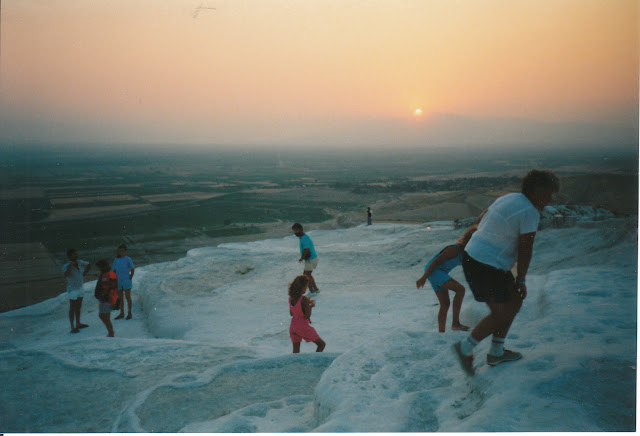On swimming the Hellespont, on May 3, 1810, Byron wrote:
'I plume myself on this achievement more than I could possibly do any kind of glory, political, poetical or rhetorical.'
I have however, swum in a number of places in Turkey, and here they are.
The BLACK SEA at TERME
20 July 1989
Looks a bit dull, but the water was fantastic and we enjoyed the swim. Really nice body surfing waves.
AKDAMAR ISLAND in LAKE VAN, Eastern Turkey
28 July 1989
"The origin and meaning of the island's name is unknown, but is often attributed to an old Armenian legend. According to the tale, an Armenian princess named Tamar lived on the island and was in love with a commoner. This boy would swim from the mainland to the island each night, guided by a light she lit for him. Her father learned of the boy's visits. One night, as she waited for her lover to arrive, he smashed her light, leaving the boy in the middle of the lake without a guide to indicate which direction to swim. They say his dying cries of "Akh, Tamar" (Oh, Tamar) can be heard to this day at night." (Wikipedia)
So the origin of its name may lie in swimming.
28 July 1989
"The origin and meaning of the island's name is unknown, but is often attributed to an old Armenian legend. According to the tale, an Armenian princess named Tamar lived on the island and was in love with a commoner. This boy would swim from the mainland to the island each night, guided by a light she lit for him. Her father learned of the boy's visits. One night, as she waited for her lover to arrive, he smashed her light, leaving the boy in the middle of the lake without a guide to indicate which direction to swim. They say his dying cries of "Akh, Tamar" (Oh, Tamar) can be heard to this day at night." (Wikipedia)
So the origin of its name may lie in swimming.
On the road from KÂHTA to MT NEMRUT
30 July 1989
A very welcome stop at a restaurant / camping site on a long and dusty trip to Mount Nemrut. Not sure of its name but it could be Damlacık
KAYA CAMPING, GÖREME, CAPPADODOCIA
2 August 1989
A lazy day, poolside. Aaaaaaaaaaaah.
SIDE
4 August 1989
After weeks inland, our first sight of the Mediterranean was at Side, where we rushed into the beautiful water and enjoyed a swim in the sea.
BELDIBI on the MEDITERRANEAN with the TAURUS MOUNTAINS in the background.
4 August 1989A pebbly shore, backed by sand, right at our campsite. Beautiful swimming in calm, crystal clear, warm Mediterranean waters.
Beach between Beldibi and Demre (Myra)
5 August 1989
I don't know the name of this beach, but it was beautiful. Entrance was 500 Turkish Lire, but that bought a deck chair. That gorgeous, crystal clear water again.
KAPUTAŞ between Kaş and Kalkan - BLUE COVE
6 August 1989
The most exquisite beach. The road crosses a mountain gorge. Below the bridge is this beautiful cove, reached by stairs from the road.
7 August 1989
Not really swimming, though people used to. Due to drought, there was not much water in this area of hot springs and travertine terraces. The ancient city of Hierapolis was founded in the 2nd century BC as a thermal spa. It is now a UNESCO World Heritage Area, and you can no longer walk over it any more like we did, nor immerse yourself in the waters.
I am glad; when we visited, they were a very big disappointment - littered with cigarette butts and a grey, dirty site. Now, apparently , they have returned to their pristine, gleaming white natural state. The terraces are formed from calcium bicarbonate carried in the spring water.
PAMUKKALE - Swimming in the ancient SACRED POOL
7 August 1989
In the grounds of what was the Pamukkale Motel (now a thermal centre) is the ancient Sacred Pool, warmed by hot springs and littered with underwater fragments of ancient marble columns. It is possibly associated with the Temple of Apollo. It was amazing swimmign around over anceinet ruins! During the Roman period, columned porticoes surrounded the pool; earthquakes toppled them into the water where they now lie.
This is where the spring that feeds the mineral pools of Pamukkale originates.


















